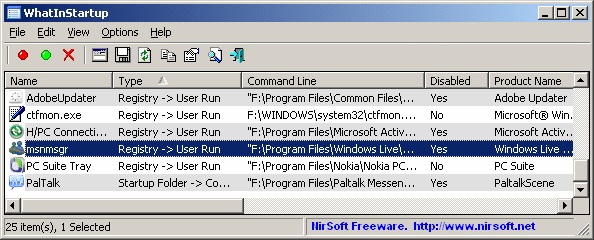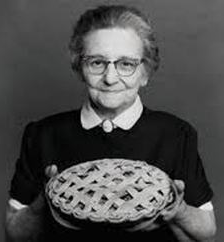Always scroll to the bottom of the page for the main download link.
We don't believe in fake/misleading download buttons and tricks. The link is always in the same place.
WhatInStartup v1.35 32bit
This utility displays the list of all applications that are loaded automatically when Windows starts up. For each application, the following information is displayed: Startup Type (Registry/Startup Folder), Command-Line String, Product Name, File Version, Company Name, Location in the Registry or file system, and more.
It allows you to easily disable or delete unwanted programs that run in your Windows startup. You can use it on your currently running instance of Windows, as well as you can use it on external instance of Windows in another drive.
WhatInStartup also supports a special "Permanent Disabling" feature - If a program that you previously disabled added itself again to the startup list of Windows, WhatInStartup will automatically detect the change and disable it again.
System Requirements
This utility works on any version of Windows starting from Windows 2000 and up to Windows 8. Both 32-bit and 64-bit systems are supported.
Versions History
Version 1.35:
Added 'Auto Size Columns+Headers' option.
Added x64 build.
Using WhatInStartup
WhatInStartup doesn't require any installation process or additional dll files. In order to start using it, simply copy the executable file (WhatInStartup.exe) info any folder you like, and run it.
After running it, the main window of WhatInStartup displays the list of all programs that are loaded at Windows startup. You can select one or more items, and then disable them (F7), enable them back after previously disabled (F8), delete them (Ctrl+Delete), or save them into text/csv/html/xml file (Ctrl+S).
Permanent Disabling
Permanent Disabling is a special feature of WhatInStartup that allows you to Permanently enforce the disabling of programs in Windows startup.
Many programs add themselves into the Windows startup list without even asking you, and even if you disable or delete them, these programs add themselves again in the next time that you use them. While WhatInStartup is running, it monitors the startup lists in the Registry and in the file system. If a disabled program added itself again into the list, WhatInStartup detect the change and automatically disable it again. This means that as long as WhatInStartup is running, the programs that you disabled won't return back to Windows startup.
If you don't want that WhatInStartup will run in the background, you can use the /pdisable command-line option: When you run WhatInStartup.exe with /pdisable parameter, it'll check all startup items that you previously disabled, and if it finds previously disabled items that are now enabled, it'll automatically disable them again for you, without displaying any user interface.
Using WhatInStartup On External Drive
If you have an operating system with booting problems, you can use WhatInStartup to disable/delete unwanted startup programs on another instance of Windows. In order to use this feature, go to Options->Advanced Options, choose the "Load the startup items from external instance of Windows" option and type the right Windows directory and profiles folder.
If you want to connect the external drive from command-line, you can use the /external command-line option.
Command-Line Options
/disable <Startup Item Name> Disables the specified startup item. You can specify the exact item name, as appeared under the 'Name' column or you can specify the full path filename of the process, as appeared in the 'Process Path' column.
For example:
WhatInStartup.exe /disable msnmsgr
WhatInStartup.exe /disable "C:\Program Files\Windows Live\Messenger\msnmsgr.exe"
/enable <Startup Item Name> Enables the specified startup item. You can specify the exact item name, as appeared under the 'Name' column or you can specify the full path filename of the process, as appeared in the 'Process Path' column.
/delete <Startup Item Name> Deletes the specified startup item. You can specify the exact item name, as appeared under the 'Name' column or you can specify the full path filename of the process, as appeared in the 'Process Path' column.
/pdisable Activates the permanent disabling process from command-line. When you run this command, WhatInStartup will check all items that you previously disabled. If it finds previously disabled items that are now enabled, it'll disable them again.
/external <Windows Directory> <Profiles Folder> Load the startup items list from external instance of Windows.
/stext <Filename> Save the list of all startup items into a regular text file.
/stab <Filename> Save the list of all startup items into a tab-delimited text file.
/scomma <Filename> Save the list of all startup items into a comma-delimited text file (csv).
/stabular <Filename> Save the list of all startup items into a tabular text file.
/shtml <Filename> Save the list of all startup items into HTML file (Horizontal).
/sverhtml <Filename> Save the list of all startup items into HTML file (Vertical).
/sxml <Filename> Save the list of all startup items to XML file.
/sort <column> This command-line option can be used with other save options for sorting by the desired column. If you don't specify this option, the list is sorted according to the last sort that you made from the user interface. The <column> parameter can specify the column index (0 for the first column, 1 for the second column, and so on) or the name of the column, like "Type" and "Command Line". You can specify the '~' prefix character (e.g: "~Command Line") if you want to sort in descending order. You can put multiple /sort in the command-line if you want to sort by multiple columns.
Examples:
WhatInStartup.exe /shtml "f:\temp\startup.html" /sort 2 /sort ~1
WhatInStartup.exe /shtml "f:\temp\startup.html" /sort "Type" /sort "Name"
/nosort When you specify this command-line option, the list will be saved without any sorting.
Examples:
WhatInStartup.exe /external "D:\Windows" "D:\Documents and Settings\Administrator"
WhatInStartup.exe /shtml "c:\temp\startup-list.html"
WhatInStartup.exe /stab "c:\temp\startup-list.txt" /external "D:\Windows" "D:\Documents and Settings\Administrator"
Translating WhatInStartup to other languages
In order to translate WhatInStartup to other language, follow the instructions below:
Run WhatInStartup with /savelangfile parameter:
WhatInStartup.exe /savelangfile
A file named WhatInStartup_lng.ini will be created in the folder of WhatInStartup utility.
Open the created language file in Notepad or in any other text editor.
Translate all string entries to the desired language. Optionally, you can also add your name and/or a link to your Web site. (TranslatorName and TranslatorURL values) If you add this information, it'll be used in the 'About' window.
After you finish the translation, Run WhatInStartup, and all translated strings will be loaded from the language file.
If you want to run WhatInStartup without the translation, simply rename the language file, or move it to another folder.
License
This utility is released as freeware. You are allowed to freely distribute this utility via floppy disk, CD-ROM, Internet, or in any other way, as long as you don't charge anything for this. If you distribute this utility, you must include all files in the distribution package, without any modification !
Disclaimer
The software is provided "AS IS" without any warranty, either expressed or implied, including, but not limited to, the implied warranties of merchantability and fitness for a particular purpose. The author will not be liable for any special, incidental, consequential or indirect damages due to loss of data or any other reason.
Feedback
If you have any problem, suggestion, comment, or you found a bug in my utility, you can send a message to nirsofer@yahoo.com

Continue below for the main download link.
|












 , out of 55 Votes.
, out of 55 Votes.
